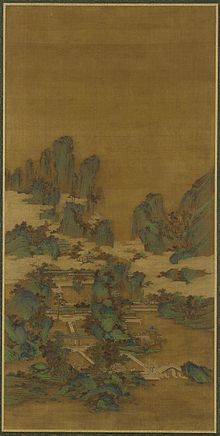| Ashǐnà Jiēshèshuai | |
|---|---|
| Shad | |
| Native name | 阿史那結社率 |
| Born | Unknown |
| Died | 19 May 639 Near Yellow River |
| Noble family | Ashina |
| Father | Shibi Khan |
| Occupation | Military commander of Tang dynasty (630–639) |
Ashina Jiesheshuai (simplified Chinese: 阿史那结社率; traditional Chinese: 阿史那結社率; pinyin: Ashǐnà Jiēshèshuai; Wade–Giles: Ashihna Chieh-she-shuai; Middle Chinese (Guangyun) pronunciation: [ʔɑʃi̯ə˥nɑ˩ kiet.ʑi̯a˥ʃi̯ue̯t]; died 19 May 639) was a member of the Ashina clan of the Eastern Turkic Khaganate and general (Zhonglangjiang) of the Tang dynasty.
Background
Main articles: Göktürks and Tang campaign against the Eastern TurksHe was one of Shibi Khan's sons and the younger brother of Ashina Shibobi (Chinese: 阿史那什钵苾), who was a vassal khagan of the Tang dynasty and used the title Tölis Khaghan. (Chinese: 突利可汗).
Tang China defeated the Eastern Turkic Khaganate, which became a vassal state in 630. During this period, some Turkic nobles were members of the Chinese army. Ashina Jiesheshuai was among these nobles.
Jiucheng Palace raid

By summer 639, Ashina Jiesheshuai had lost favor with Emperor Taizong (because he had falsely accused his brother Ashina Shibobi of treason, which Emperor Taizong found despicable). He formed a conspiracy with Ashina Shibobi's son Ashina Hexiangu (Chinese: 阿史那賀暹鶻) to assassinate Emperor Taizong at his summer palace called the Jiucheng Palace (九成宮, in modern Linyou County, Shaanxi). They had planned to wait for Li Zhi, the Prince of Jin, to depart from the palace in the morning and use that opportunity to attack the palace. On the day they planned, 19 May, Li Zhi did not leave the palace due to a storm. Ashina Jiesheshuai attacked the palace anyway, engaging the palace guards, but the guards were supported by troops who came outside. Ashina Jiesheshuai and his comrades stole some 20 horses from the stable. They fled to the north, but were caught by pursuers near the Wei River and killed. Ashina Hexiangu was exiled to Lingbiao.
After this incident, officials began advocating for the sending of Turks (or Tujue, as they were known to the Chinese) away from the heart of the state. In fall 639, Emperor Taizong created a Tujue prince who had served him faithfully, Li Simo (né Ashina Simo) as the khan of a newly recreated Eastern Tujue state as Qilibi Khan, giving him all of the Tujue and Hu who had surrendered as his subordinates, to be settled north of the Great Wall and the Yellow River. The Tujue people were fearful of Xueyantuo and initially refused to go to their new location. Emperor Taizong issued an edict to Xueyantuo's khan Yi'nan that he and Li Simo keep their peace and not attack each other, and after receiving from Yi'nan the assurance that he would not attack, the Tujue people moved to the new location.
Aftermath
Jiesheshuai's rebellion was unsuccessful. However, in 681, Qutlugh revolted against Tang and established the Second Turkic Khaganate in 682.
Cultural influences
Main article: Kürşat (hero)A prominent Turkish nationalist, Nihal Atsız, used some characteristics of Ashina Jiesheshuai for a fictional character named Kür Şad in the novel Bozkurtların Ölümü (The Deaths of Gray Wolves). However, in the novel, the father of Kürşad is not Shibi Khan but Ashina Xichun (Çuluk Kağan).
See also
References
- New Book of Tang Vol. 2
- ^ Zizhi Tongjian, vol. 195.
- ^ Old Book of Tang Vol. 194-1
- New Book of Tang Vol. 215-1
- Old Book of Tang Vol. 3
- Jean-Paul Raux:Histoire des Turcs (Ttans:Aykut Kazancıgil,Lale Arslan Özcan) Kabalcı yayınları, İstanbul 2007 ISBN 975-997-091-0 p. 102
- jia'shen day of the 4th month of the 13th year of the Zhen'guan era, per vol.195 of Zizhi Tongjian. Emperor Taizong's biography in Old Book of Tang gave the same date. (十三年....夏四月....甲申,阿史那结社尔犯御营,伏诛。) Jiu Tang Shu,vol.03
- Nihal Atsız (1974). Bozkurtlar. Ötüken. p. 31.
- Güngör, Erol (1988). Tarihte Türkler. Ötüken. p. 86.
| Göktürks | |
|---|---|
| First Turkic Khaganate (552–581) |
|
| Eastern Turkic Khaganate (581–630) | |
| Western Turkic Khaganate (581–657) | |
| Second Turkic Khaganate (682–744) | |
| Western Turks under Jimi system |
|
| Göktürk culture | |
| Göktürk wars and battles | |
| Titles | |
| Family | |